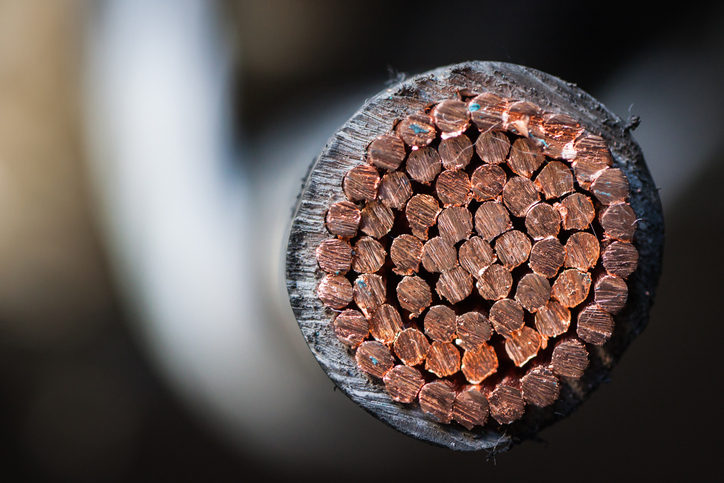Copper is a metal of the past. Its time has come and gone. Right? Not so fast.
Many modern technologies have thrust copper back into the spotlight. EVs are just one of many examples.
According to the International Copper Association, EV copper demand in 2017 was 185,000 tons. By 2027? That number is projected to skyrocket to an incredible 1.74 million tons.
As green technologies turn increasingly to electrification, copper has been thrust back into the spotlight. Despite a history that stretches back for millennia, it may be true that copper has never been as important, or as relevant, as it is today.
Why Copper is King in the Age of Electrification
To understand the increasingly important role that copper plays in our electrified world, it’s necessary to understand the concept of conductivity. Simply put, this is the measure of how well a material conducts an electrical current. To build electronics, the goal is to use highly conductive materials so as little current as possible is lost along the way.
Almost nothing in the natural world is as conductive as copper. According to Engineering ToolBox, only silver is more conductive as a material, with copper registering 94.6% of the conductivity of silver. And, since copper is far more affordable as a material than silver, it has become the go-to option for wiring our high-tech world.
By comparison, aluminum is another material that can be used to conduct electricity. It’s affordable and easy to work with, but can’t even come close to comparing to copper in terms of conductivity. It’s only 59.8% as conductive as silver, leaving it far short of what copper delivers. In fact, no other metal comes close, so copper will be the default choice for electronic applications for years to come.
The Role of Copper in the Green Revolution
As the global focus turns more and more toward renewable sources of energy that are kind to the environment, the demand for copper continues to grow. We mentioned EVs briefly in the introduction, but that market deserves a closer look here because it highlights just how critical copper is to sustainability efforts.

Research from the Copper Development Association indicates that the average vehicle with an internal combustion engine includes just under 50 pounds of copper. That might sound like a lot, but it pales in comparison to what is required in an EV. The average electric vehicle includes more than 180 pounds of copper. This means that for each new car that rolls off the line with an electric motor rather than a gas engine, more than three times as much copper is required.
And it’s not just EVs that rely on copper electrification to make our vision of a cleaner environment a reality. Sources of renewable energy, like wind turbines and solar panels, are also highly reliant on this metal. The average onshore wind turbine includes three metric tons of copper for each megawatt of capacity, according to a study by the International Energy Agency.
The mission-critical nature of copper ties back to the discussion of conductivity earlier on this page. Since it is so much more efficient than virtually all other metals, there is no ready replacement for copper. It is absolutely necessary to keep progressing the world toward a greener future.
Our Digital Lives Already Run on Copper
Electric vehicles and wind turbines are examples of how copper is necessary to create large machines and powerful motors. If those examples don’t hit close to home, consider that all of us use devices each day that also rely on copper.
Today’s mobile phones are dependent on copper to create the circuitry that enables the device to work. The Natural History Museum identifies copper as the single most important mineral in your smartphone. Other key components include tellurium, lithium, cobalt, and manganese.
Of course, those devices aren’t useful unless they can connect to a network – and, yet again, copper plays a key role in that area. Countless tons of copper are found in the data centers that allow devices around the globe to communicate with one another.
An Approaching Copper Crunch
The overwhelming need for copper green energy in larger and larger quantities begs an obvious question. Where is it all going to come from?
There is plenty of concern about a copper shortage in the years ahead. A paper published by professors at the University of Michigan pointed to precisely that issue. The study looked at 120 years of data from copper mines and determined that the current infrastructure cannot support the coming demand.
Part of the problem is the time it takes to get a new copper mine up and running. This paper finds that several new mines will need to come online each year to keep up with demand, but the average mine takes 20 years from discovering copper in the ground to actually mining it. These permitting delays make it impractical to quickly and efficiently scale up the volume of copper mining.
There are also political implications to consider. Copper mining does occur in the United States, but it is also concentrated in other areas of the globe, such as Chile and Peru. Depending too much on copper from foreign sources could open up strategic vulnerabilities that threaten economic stability.
What Consumers and Builders Need to Know
Prices always rise along with demand. So, when looking at the strong future market for copper, it’s reasonable to expect that copper prices will climb in the years to come.
That’s an important factor to keep in mind for electric vehicle manufacturers, or other corporations that utilize large volumes of copper in their projects. For individual consumers, however, it’s not so much of a concern.
As mentioned earlier, the average EV uses more than 180 pounds of copper. It’s easy to see at that scale how price increases could make a notable impact. For the consumer thinking about purchasing something like a copper sink, however, climbing prices aren’t such a significant impact. After all, a sink would only use a tiny fraction of the copper that is used in an EV, so any price increases will be modest.

The durability of copper also gives it tremendous value and makes the material a worthy investment. Products crafted with copper can be expected to stand the test of time and won’t need to be replaced anytime soon. That’s another piece of the sustainability puzzle. It also means that any extra costs incurred due to rising copper prices will be recovered thanks to the long-lasting nature of the metal.
Copper Will Power Us Forward
We all know that copper is beautiful. It’s been appreciated for its aesthetic appeal for thousands of years, and that’s not changing anytime soon.
But copper is now more than a material that is used to create stunning items. It’s now an integral part of our daily lives. Copper technology use creates infrastructure. It brings countless new possibilities to life. And, thanks to the way it supports eco-friendly advances, it just might help save the planet along the way.
At CopperSmith, we love being part of this industry and bringing the beauty and function of copper to our customers. Our custom range hoods, tables and sink are pieces that represent just one of the many ways that copper is going to make a lasting mark on the world.
